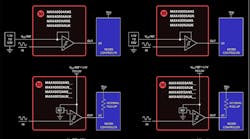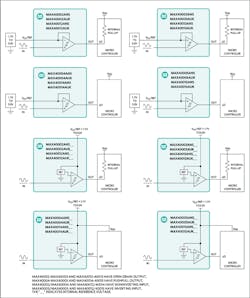Ultra-Tiny Comparators: Doing One Function Well—with Ultra-Low Power
Given the high levels of single-chip integration in use for analog functions, it may seem that a basic standalone comparator IC is an anachronism. Perhaps that’s the case, but Maxim Integrated doesn’t think so, as the company recently announced of family of eight nanopower comparators, including some housed in 4-bump, “grain of sand,” ultra-tiny, 0.73- × 0.73-mm wafer-level (WLP) packages.
Why use a discrete comparator when it’s relatively easy to add that function to almost any analog or even digital IC? There are many reasons. Sometimes, a device needs continuous on/off-threshold comparison, and using a comparator significantly reduces power demands as well as need for the system resources of using an analog-to-digital converter (ADC) and channel, an ongoing software-comparison loop, and digital output pin. The comparator is a simple, crisp, no-hassle way of solving that monitoring problem.
In other cases, a digital signal has the opposite high/low sense of what’s needed, whether due to unavoidable interface incompatibility or perhaps even a designer mistake (hey, it happens), and a comparator offers a way to invert that signal. A comparator can also facilitate the interface transition between one signal type and another, such as an open-drain driver and load.
The family consists of the MAX40002, MAX40003, MAX40012, and MAX40013 with open-drain outputs, while the MAX40004, MAX40005, MAX40014, and MAX40015 feature push-pull outputs (see figure). The MAX40002, MAX40004, and MAX40012 to MAX40014 have noninverting inputs, while the MAX40003, MAX40005, and MAX40013 to MAX40015 maintain inverting inputs.
In addition to the ultra-low 500-nA operating current that preserves battery power, especially attractive for situations where the comparator is in a constant-monitoring role, the 1.7- to 5.5-V supply range allows for operation from 1.8-, 2.5-, 3- and 5-V system rails. Propagation delay is just 9 μs.
These devices include an internal reference, which makes sense because so many comparator applications assess the unknown input against a known, fixed threshold. Of course, the reference can be bypassed if needed for adjustable or adaptive threshold cases. The desired reference voltage is preset at the factory per customer order with voltage options of 0.2, 0.5, 0.9, or 1.222 V, while the external reference range is 1.7 to 5.5 V.
For designs that don’t need or want the nearly invisible WLP packaging option, these comparators are also offered in 5-pin SOT23 packages. Thermally challenged applications are well-served by these biCMOS devices, too, as they’re fully specified over −40 to +125°C automotive-temperature range. The datasheet provides the details on the comparator versions, performance versus various parameters, and applications insight.

